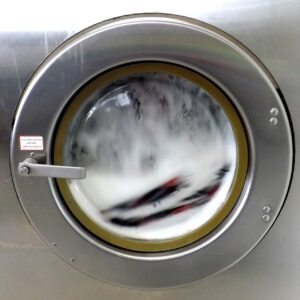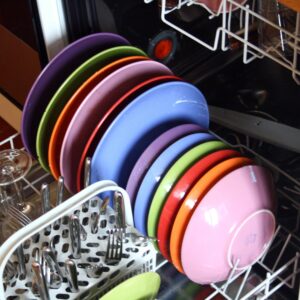Best Practices for Loading a Dishwasher
-
 By
Ava Thompson
By
Ava Thompson

Want spotless dishes? Then this guide is for you! In this post, we will be going over how to load a dishwasher correctly, including how to prepare your dishes, arrange them on different racks, as well as some common mistakes to avoid.
Table of Contents
TogglePreparing Your Dishes for the Dishwasher
Before you load the dishwasher, there are a few things you want to do to ensure that it runs properly.
Supplies:
- Rubber spatula
Step 1:
Using a rubber spatula, scrape off any large food particles and debris from the dishes. That will prevent the filter from clogging and will ensure proper cleaning.

Step 2:
Not all items are dishwasher safe. Before you load your dishes, make sure to double check.
For example, delicate items such as fine china, wooden utensils, and cast iron should be hand washed instead to prevent damage.

Pre-rinsing your dishes is unnecessary as modern dishwashers and detergents are able to handle food residue effectively.
Loading the Bottom Rack
Certain things belong in the bottom rack as opposed to the top rack or utensil tray.
Step 1: Place Dinner Plates and Bowls

Place dinner plates and large bowls on the bottom rack, angled inward toward the center spray arm; that will help improve cleaning, drying, and draining.
Make sure they are not blocking the spray arms as that will prevent them from being cleaned properly.
Step 2: Place Pots and Pans

Place pots and pans on the bottom rack with them facing downward over the tines. Avoid placing wood, aluminum, and cast iron in the dishwasher as they are not suitable for this type of washing and will become damaged.
Step 3: Place Cutting Boards and Flat Pans

Place cutting boards and flat pans at the sides or back of the bottom rack to avoid blocking the spray arms.
Supply:
- None
Loading the Upper Rack
The top rack is ideal for smaller items like mugs, stemware, small plates, and bowls. For the best results, position them facing the center and make sure they are angled downward toward the spray jets.
Supplies:
- None
Step 1:
Place small bowls and plates on the upper rack vertically. To maximize cleaning efficiency, position them between the tines, angled downward toward the center.

Step 2:
Place drinkware and wine glasses upside down for proper drainage.
Make sure they are secure in their spots so they won’t move and break during the wash cycle.

Step 3:
Place plastic items such as containers upside down on the upper rack.

Loading the Utensil Basket
Small utensils such as forks and spoons should go in the utensil basket.
Supplies:
- None

Step 1:
Place forks and spoons handles down in the utensil basket to prevent nesting. If necessary, alternate their placement to avoid nesting.
Place knives blade down in the utensil basket to avoid accidents.

Step 3:
Load large utensils horizontally on the top rack if there’s no dedicated basket space. This will prevent them from blocking the spray arms.
Utilizing the Third Rack
The third rack is designed to hold large, flat items; this includes things like silverware, measuring cups, and spatulas.
Supplies:
- None
Step 1:
Position long utensils like spatulas and ladles so that they are laying flat on the rack.

Step 2:
Place mugs at a slight angle to prevent water from pooling. Small bowls, on the other hand, should be angled downward towards the spray arms for proper cleaning.

Common Mistakes to Avoid
Avoiding common mistakes can greatly enhance your dishwasher’s performance. Here are some things to avoid:
Overloading the Dishwasher
Avoid overcrowding the dishwasher. In other words, don’t stack or nest items; that will prevent water from reaching the dishes, leading to unclean dishes, potential leaks or damage.
Blocking Spray Arms
Placing bulky items incorrectly can obstruct the spray arms, reducing their effectiveness. Given that, you want to make sure larger items are placed on the bottom rack.
Using Too Much Detergent
Using too much detergent can leave a filmy residue on glassware. Always follow the dosing instructions on the packaging for optimal results.
Running the Dishwasher
Running the dishwasher effectively requires more than just pressing the start button. For one thing, you want to keep the filter clean.
To maximize efficiency, it’s also recommended that you run the dishwasher only when it’s full.
Supplies:
- None

Step 1:
Add dishwashing detergent. To avoid residue, use the right amount as specified in the directions.

Step 2:
If necessary, add rinse aid. It will improve the drying process and prevent streaks from developing on glassware.
Just remember that you do need to replace commercial rinse aid periodically, ideally once a month.

Step 3:
Select the proper washing cycle, depending on the dishes you’re washing.
For heavily soiled dishes, select a longer or more intensive wash cycle. Lightly soiled dishes, on the other hand, can be cleaned with a quick or eco-friendly cycle.
Unloading the Dishwasher
Unloading the dishwasher in the right order can make a big difference.
Supplies:
- None
Step 1:
Start unloading from the bottom rack to prevent water from dripping onto the clean dishes below.

Step 2:
Before putting your dishes away, inspect them for any remaining food particles.
While modern dishwashers are designed to handle food residue effectively, it’s always good idea to check for missed spots.
If you find any food residue, consider reloading and running another cycle with dishwasher detergent. You can also rinse it in the sink.

Step 3:
After cleaning, be sure to store your dishes properly. This means grouping similar items together and putting them away in the kitchen cabinets.

Knowing How to Load a Dishwasher Properly
Loading your dishwasher properly will ensure that your dishes come out sparkling clean every time. From preparing your dirty dishes to choosing the right wash cycle, every step plays a crucial role.
By following these tips, you’ll be able to maximize your dishwasher’s efficiency and longevity.
Key Takeaways
- Scrape off large food particles before loading
- Pre-rinsing isn’t necessary as modern dishwashing detergent works better with some food residue
- Place larger items in the bottom rack and smaller items in the top rack, making sure the spray arms aren’t blocked
- Unload the bottom rack first to prevent water from dripping onto clean dishes and always check for food residue before putting them away
Loading Your Dishwasher – Frequently Asked Questions
Do I need to pre-rinse my dishes before loading them into the dishwasher?
You don’t need to pre-rinse your dishes before loading them into the dishwasher. Just make sure to scrape off any large food bits, and let the dishwasher do the rest!
What items should I avoid putting in the dishwasher?
You should steer clear of putting delicate items like fine china, wooden utensils, and cast iron cookware in the dishwasher, as they can easily get damaged. Hand washing is the best way to keep them safe.
How should I load large pots and pans?
To load large pots and pans, position them facing downward over the tines and place them along the sides or back of the lower rack to avoid damage.
How can I avoid overloading my dishwasher?
Make sure to load the dishwasher from back to front and keep items separated so that they can be cleaned properly during the cycle. Avoid stacking or nesting items.
SAVE
15% off
Your Next ACTIVE
Purchase on Amazon
15% Off Your Order on Amazon
×Click below to reveal the 15% off coupon for your entire ACTIVE purchase on Amazon.com
Limited Time Offer




